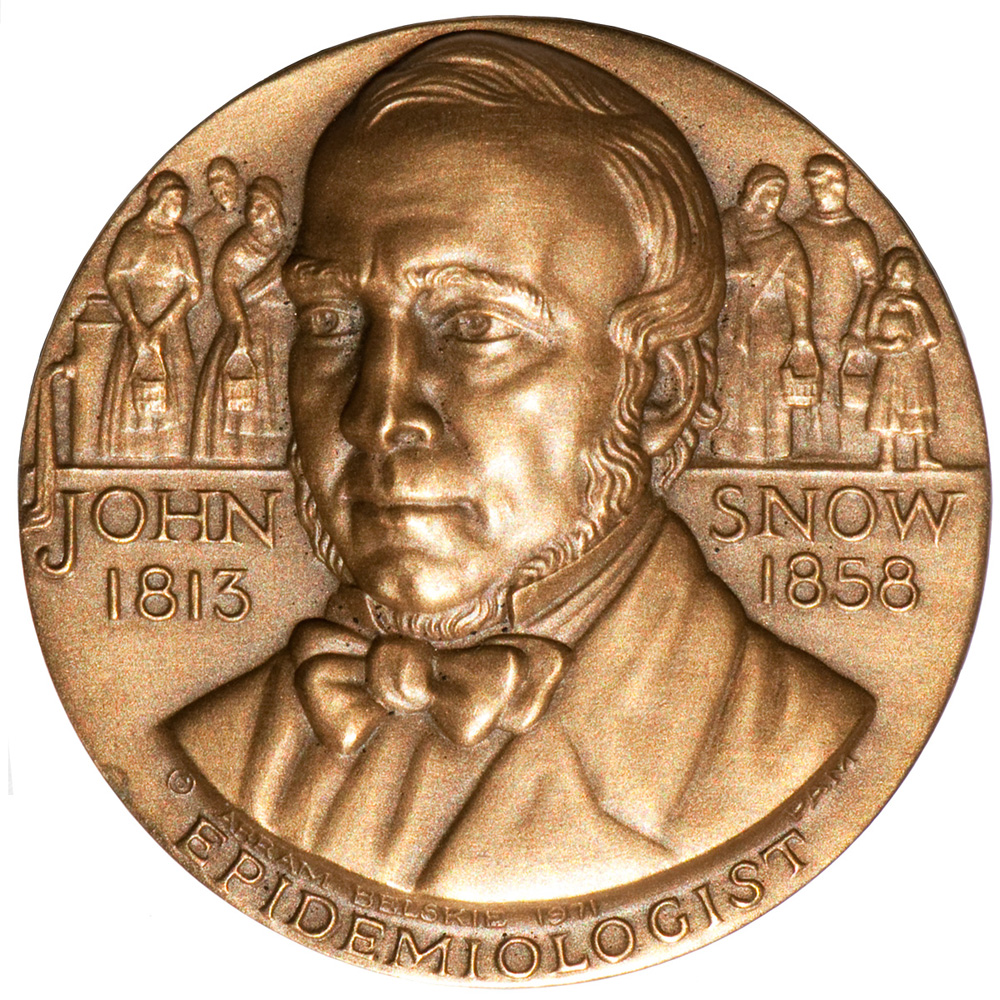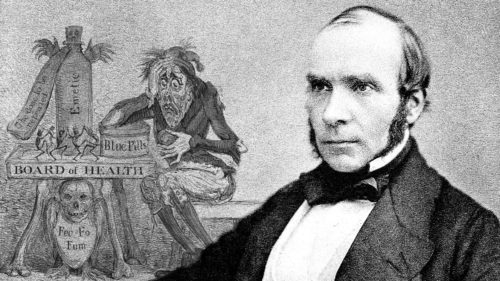John Snow: Water Pumps, Cholera and Epidemiology
I live in no fear that telling you Dr. John Snow is one of history’s top 50 influential doctors will give even the slightest concern.
If it does, it means you really have no clue that he was the one who basically took Cholera off the front page of every newspaper and gave the world toilets, sewer systems and public works departments—world-wide.
Dr. John Snow, father of the field of epidemiology and researcher against Cholera
John Snow (1813 – 1858) – #38
Commoner, Physician, Epidemiologist
Life in 1800’s England bore almost no resemblance to what we know today. Even hard-working men and women were in poverty if they were “commoners”; and poverty… well, that was quite a few steps lower than the condition with the same name today.
The Thames river was used for both a drinking water supply AND a sewage dump. All of the closely-packed houses had a cess-pit under the house dug decades before and some communities had a common open pit cesspool; but, all of them were decaying and leaking.
Areas often had a common community well dug haphazardly without even the knowledge of bacteria or viruses; much less that they were the cause of disease and not the “miasmus” (evil air vapors) that everyone thought.
Some paid to have their cess-pits emptied (and dumped into the river) before they overflowed; some paid to have water (from the river) delivered to them instead of gathering it from the community pump; few had their own wells; even fewer drank distilled water for no scientific reason.
Early Life and Education of John Snow
The poorest neighborhood in the city was where John was born on 15 March 1813, the first of the nine children of William and Frances Snow, laborers in the coal yard near North Street in York England.
The area was poor by reason. It regularly flooded from the River Ouse and was contaminated from market squares, cemeteries and sewage waste—he knew poverty. Later the family moved to the edge of the city where William became a farmer.

John showed a destiny for mathematics early and, when 14, was apprenticed to William Hardcastle in a medical apprenticeship. In 1832 he encountered a Cholera epidemic for the first time during a surgeon-apothecary apprenticeship. Such training contracted him “not to drink, gamble or marry.” He became a vegetarian and pledged to drink only distilled water that was “pure.”
Between 1833 and 1836 Snow worked as an assistant to a colliery surgeon, first in Burnopfield, County Durham, and then in Pateley Bridge, West Riding of Yorkshire. In October 1836 he enrolled at the Hunterian school of medicine on Great Windmill Street, London.
In 1837, Snow began working at the Westminster Hospital. Admitted as a member of the Royal College of Surgeons of England on 2 May 1838, he graduated from the University of London in December 1844 and was admitted to the Royal College of Physicians in 1850.
John set up a private practice but continued academic inquires through his life. He wrote an article “On Asphyxiation, and on the Resuscitation of Still-Born Children” in 1841; an essay in 1849 “On the Mode of Communication of Cholera” opining against “vapors” as the cause; and a pamphlet in 1857 on “the adulteration of bread as a cause of rickets.”
His forte however was the study, quantification and delivery of the anesthetic’s ether and chloroform. Literally, for everything except the publication, he “wrote the book” on ether as an anesthetic. Of course the clergy at the time decried its use in alleviating the pain of childbirth as sacrilege; but, when Queen Victoria asked him to administer chloroform to her during the birth of her last two children, the angst seemed to diminish.
He was the one who calculated the original doses and found that it was a lot safer when administered by someone other than the surgeon in operations.
Later life:
None-the-less, it was for his dogged detective work during a 1954 Cholera outbreak in Broad Street, Soho, London that John achieved his “most influential physician in history” status. Already on record as disagreeing with the “miasmus” theory of the disease, he tirelessly researched the epidemic which killed over 600 in the area.
Living near the community pump on Broad Street, Smith studied first hand the epidemic in 1854 where within 250 yards of the pump over 500 fatal attacks of cholera occurred within 10 days!

Painstakingly (because he knew it went against current knowledge about disease) he accounted for the fact that all deaths, except 10, lived near and drew water from the Broad Street pump. Eventually, he found that even those ten had obtained water in one way or another from that pump.
In addition, he accounted for those area residents who DIDN’T contract cholera by discovering they either consumed water from a private well at their place of work (or a prison) or they had a private well themselves. And, he showed that cases of people living farther away from the pump came from going to school near the pump, or frequenting a pub or café who obtained their water from the well.
Unfortunately, there were no microscopes or techniques which would allow Dr. Snow to definitively determine there was cholera in the water but he did “see white specks in the water.”
With his detailed information, maps with dots on them and statistics he gained audience with the community leaders who took the handle off the pump so people couldn’t use it—with the resulting decrease in cases. They didn’t believe his warning, however, and later restored the pump after the “panic” had died down.
It wasn’t until much later that Snow’s detractors and disbelievers proved him to be correct by trying to prove him wrong. One reverend, Whitehead, tried to show it was “God’s divine intervention” that was causing the disease; but instead interviewed a woman who admitted that she had washed her baby’s diapers (ill with the disease) and dumped the water into the cesspool 3 feet from the Broad Street well.
Still later another detractor proved that the well had indeed been dug only 3 feet from the public cesspit and that it had begun to leak fecal material. And yet another, investigated another outbreak in 1866 and finally had to admit the validity of Snow’s claims.
The following year a magazine took up the cause by publishing both of the former detractor’s results and demanding that the city institute repairs on its sewage and drinking water systems—which, of course, they didn’t for many years.
Not until 1883 was the cholera bacteria isolated by a German physician, Robert Koch, and Snow’s discoveries validated. The cholera epidemics in Europe and the United States didn’t resolve until the 19th century when cities finally improved water supply sanitation.
John became a member of the temperance movement in 1830 and lived as a vegetarian for ten years until his health deteriorated. He continued drinking pure water (via boiling) throughout his adult life. He never married and was alone when he suffered a stroke while working on 10 June 1858 (45) and died six days later.
Biographic Summary
John Snow was the father of epidemiology for his detective work on a Cholera epidemic.
Born: 15 March 1813, North Street in York England
Died: 16 June 1858
Education: Apprenticeships and medical school
Known for: Proposing a water contamination link with Cholera, developing anesthesia techniques used on Queen Victoria, a founding father of epidemiology.
Parents: William and Frances Snow
26 Posts in Top 50 Doctors (top50) Series
- 26 - Carlos Chagas, Chaga's Disease & pneumocystis pneumonia. – 10 Apr 2025
- 27 - Charles D. Kelman - Cataracts – 9 Mar 2023
- 28 - Cicely D. Williams, Kwashiorkor, Breastfeeding, Whistleblower – 21 Jun 2022
- 29 - Dame Cicely Saunders, Hospice – 23 Apr 2018
- 30 - David L. Sackett, Evidence-based Medicine – 2 Apr 2018
- 31 - E. Donnall Thomas & Joseph Murray, Bone Marrow Transplants – 23 Feb 2018
- 32 - Elizabeth Blackwell, women in medicine – 29 Jan 2018
- 33 - Elisabeth Kübler-Ross, stages of grief – 5 Jan 2018
- 34 - Watson & Crick, DNA – 2 Dec 2017
- 35 - Mahmut Gazi Yaşargil, Micro-Surgery – 24 Oct 2017
- 36 - George Papanicolaou, Cytopathology, Cancer – 29 Sep 2017
- 37 - Dr. James Parkinson, Parkinson's Disease – 1 Sep 2017
- 38 - Dr. John Snow, cholera – 20 Aug 2017
- 39 - Dr. Joseph Kirsner, GI Joe – 27 Jul 2017
- 40 - Lawrence (Larry) Einhorn, chemotherapy – 16 Jun 2017
- 41 - Robert Koch, modern bacteriology – 21 Mar 2017
- 42 - Stanley Dudrick, TPN – 28 Feb 2017
- 43 - Stanley Prusiner, neurodegenerative diseases – 25 Jan 2017
- 44 - Victor McKusick, medical genetics – 3 Jan 2017
- 45 - Virginia Apgar, anesthesiology & newborn care – 12 Nov 2016
- 46 - William Harvey, circulation – 12 Oct 2016
- 47 - Zora Janžekovič, burns – 26 Sep 2016
- 48 - Helen Taussig, blue babies – 3 Sep 2016
- 49 - Henry Gray, anatomy – 3 Jul 2016
- 50 - Nikolay Pirogov, field surgery – 11 Jun 2016
- Top 50 Doctors: Intro/Index – 10 Jun 2016
Advertisement by Google
(sorry, only few pages have ads)

